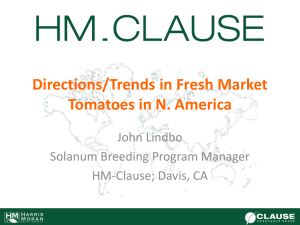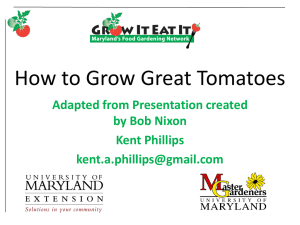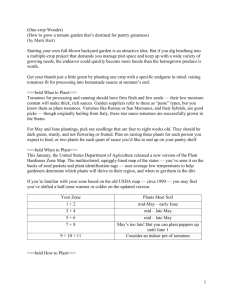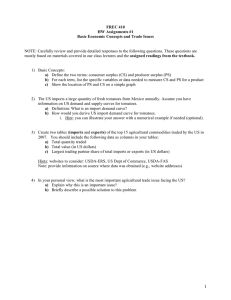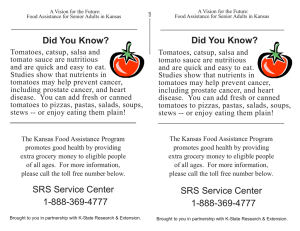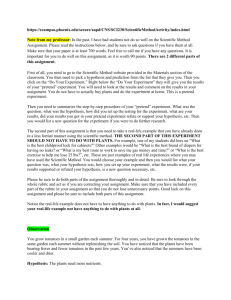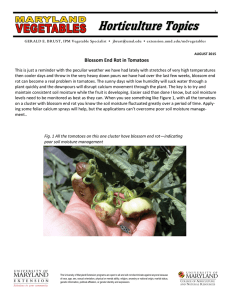MG8 How to Grow Great Tomatoes
advertisement
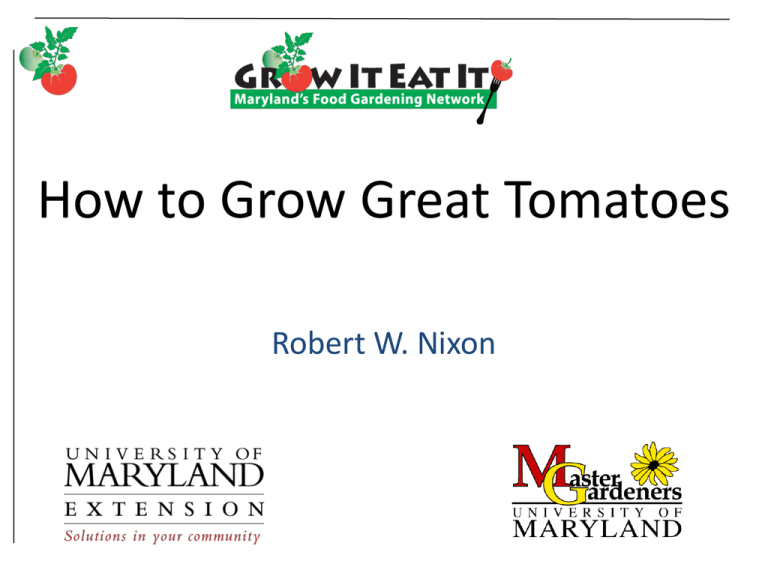
How to Grow Great Tomatoes Robert W. Nixon Also by these 27 other Howard County Master Gardeners… Linda Branagan, Columbia Diane Brown, Westminster Drenda Collins, Clarksville Linda Decker, Highland Michelle Domangue, Columbia Aylene Kovensky Gard, Columbia Leslie Gilbert, Mt. Airy Corliss Glennon, Dayton Pat Greenwald, Sykesville Joyce Halasz, Ellicott City Jane Hayes, Clarksville Jerry Kissel, Ellicott City Paul Kojzar, Ellicott City Chris McComas, Woodbine Holly McFarland, Columbia Shelley McNeal, Clarksville Ron Newmister, Dayton Barbara Nibali, Ellicott City Rosemary Noble, Ellicott City Sylvia Rampini-Huestis, Columbia Jo Ann Russo, Sykesville Paul Rutter, Elkridge Carolyn Taggart, Columbia Louisa Rogoff Thompson, Columbia Barbara White, Ellicott City Jan Marie Williams-Nguyen, Columbia Lisa Wingate, Ellicott City College of Agriculture and Natural Resources Tomato basics/botany • Member of the nightshade family • Other members: peppers, potatoes, tobacco, & eggplants • Native European members included belladonna, mandrake, and henbane, all poisonous and without edible fruit • Tomato leaves, stems, & green fruit contain a glycoalkaloid Tomato basics/history • Origin: west coast of South America • Spanish explorers: Aztecs sold tomatoes in their markets and made sauces from them • Aztec “tomatl” became Spanish “tomate” and eventually English “tomato” • Spanish & Italians first used for food in Europe, but others considered it poisonous Tomato basics/site selection Tomatoes flourish in (1) good, well-drained soil and require a (2) minimum of 6 hours (preferably 8-10 hours) of direct sunlight and (3) approximately an inch of water a week. Plants have vigorous root systems Tip: Add compost to your garden soil to improve it from year to year “Add compost, compost, and more compost. I use leaves, grass clippings, and kitchen scraps to make it. I incorporate it into the garden bed after it has finished aging (3 to 6 months).” Shelley McNeal & Lindy Growing tomatoes in containers Containers can solve problems, such as bad soil & high-rise living, but requirements for the plants remain the same *Mention of a brand names is for purpose of illustration and not endorsement You can make your own containers HGIC Publication 600, Container Vegetable Gardening, contains detailed how-to information, including diagrams for making your own containers from 5gallon buckets. Paul Rutter Tip: Deer & lots of other critters love tomatoes. Fence them out! Clarksville’s finest Starting your tomato seeds Too many seeds? 34 Early Girl seeds in $1.09 packet = $.04 each + $.14 for each of 36 cells of $4.94 Seed Starter kit = approximately $.18 each tomato seedling. Store them in an airtight container in a cool, dry place, such as refrigerator or freezer. They will remain viable for 5 to 7 years, though germination rate will decline each year. Tip: Start seeds 4-8 weeks before setout date in sterile, soilless medium in a 75-degree F. location under fluorescent lights. Standard cool-white fluorescent bulbs work well. Adjust the lights so they remain 1”-2” above the seedlings. Consider your utility room … a greenhouse without glass 3-6 mil. clear plastic draped over lights would increase humidity and air temperature I use trays with grids, yoghurt cups, marker, & a Phillips screwdriver Punch drainage holes & use widely available sterile seeding mix Pat Greenwald’s home mix: 1/3 each of perlite, milled sphagnum peat moss, & horticultural-grade vermiculite Fill cup ½ with starter mix, drop in seed & cover with mix, water … About 5 to 7 days later … About a week later, thin seedlings with scissors to one per cup … Damping off: Root rots that kill seeds or seedlings “A number of soil-borne, fungal and bacterial root rots affect a wide range of vegetable crops. Three fungal diseases … are collectively referred to as ‘damping off’…. Seedlings grown inside homes under fluorescent lights and in greenhouses succumb to damping-off if the medium is poorly drained and kept too wet.” -- UME’s Home and Garden Information Center website Tip: Prevent damping-off diseases by (1) using sterile, soilless starting mix, (2) watering plants from bottom after the mix has dried slightly, and (3) removing infected plants immediately. Additional safeguard: cover seeds with ¼” vermiculite, sand, or other sterile material. Tip: Periodic repotting results in strong seedlings “I transplant seedlings from 2- to 4- to 6-inch pots. Each time, I remove the lower leaves, so just the top 2 inches of leaves remain. I replant them deeply in the larger pot. The result is great seedlings with strong root systems.” Jane Hayes with ‘San Marzano’ Tip: Begin hardening off seedlings 10 to 14 days before transplanting “Hardening off” means introducing your plants to outdoor living: light, wind, temperature differences Best time to plant? • When soil temperature reaches 55 to 60 degrees • Here, usually mid-May to 1st week of June • Can plant earlier if plants are protected • If planted early, plants may grow slowly & be subject to insect & disease attacks • But choice plant varieties may not be available then at retailers, so buy & hold Transplanting tips • Cloudy, wind-free day – or late afternoon • Dig holes in soil improved with compost; mix in 1/4 cup of garden fertilizer, a small handful of gypsum or lime, and a pint of water • Remove leaves except top-2-3 inches • Set plants deep, to just below remaining leaves, and protect from harsh weather • Mulch ASAP & water as needed The perfect collar: toilet paper roll The collar protects the stem from cutworms, which are moth larvae (caterpillars) that live just underground and may sever young plants near ground level. Paul Kojzar: Planting “I plant tomatoes where I did not grow tomatoes last year. I dig a hole about 2’ wide and 2’ deep and fill it with a 50:50 mix of my organic compost and existing soil from my garden. For each plant, I add ½ cup of hydrated lime* and a cup of dry chicken manure. Finally, I mulch my tomato patch with a 2”-deep mix of shredded leaves and grass clippings.” * Caustic: read directions carefully Ron Newmister: Planting I “I make a hole approximately 8” deep and 12” wide. I use half garden soil mixed with half well-aged (> 6 months) horse manure (1-1-1). Compost/cow-manure mixtures available in 40-lb. bags work just as well. Put half of the soil/manure mixture in the bottom of the hole…. Ron Newmister: Planting II “Pinch all leaves from plant except for the top 1 or 2 groups. Place plant in hole at an angle of 30 degrees to the soil surface with the top pointing to the northeast. The strong spring/early summer (southwest) sun will pull the plant to the vertical in 1 or 2 days.... Ron Newmister: Planting III “Fill planting hole with the remaining half of the soil/manure mixture, leaving approximately 2” of the stem above the soil surface. Side dress each plant when approximately 6” tall with ¼ cup of lime plus ¼ cup of 10-10-10 fertilizer.” Paul Rutter creates his own organic fertilizer mix Paul Rutter Tip: Stake or cage and mulch your plants to prevent diseases and facilitate access Stake ‘em … Aylene Gard Barbara White Cage ‘em … Ron Newmister Ron Newmister: Making cages I “I make circular cages out of concretereinforcement mesh, which is a steel, fencelike material with a 6” grid. It’s available in rolls that are 5’ high by 25’, 50’, or 100’ in length. Cutting at every 17th grid results in a cage approximately 4 ½’ high and 8’ in circumference and 2 ½’ in diameter…. Ron Newmister: Making cages II … Cut the horizontal wire from the cage bottom so the remaining 6” vertical pieces can be pushed into the soil for stability. A single piece of 5’ rebar, a steel fence post, or a pointed wooden stick can be driven alongside and tied to the cage to help the plant survive our occasional hurricane. Add 3 to 4” of mulch, such as straw or grass clippings, before installing the cage.” Paul Kojzar: Caging “I use a two-layer caging system to hold my plants in place. The first layer is a traditional tomato cage, while the second layer is a 3’diameter round cage made from concrete reinforcing mesh with 6”-openings and 5’ tall.” The mulch often recommended: Straw … newspaper, compost, plastic … any barrier between leaves and soil Paul Rutter Train ‘em … Pat Greenwald with ‘Costoluto Genovese’ Ron Newmister: Training tomatoes “As the plant grows, bring the branches through the grids to the outside of the cage. Do this every 2 or 3 days. If the branches get too long while inside the cage, they will break when you try to bring them through the grids.” Two kinds of store-bought ties Jute, sisal, cotton, Velcro … Plastic stretch ties Most-used tie by HoCo Master Gardeners: pantyhose tops To sucker, or not to sucker? “Suckers are the little vegetative growths that arise at the junctions of the stem & the side branches. They have no useful purpose….” “Prune them if you are a sucker-pruner. Pinch them if you are a sucker-pincher. Let them go & things will get pretty dense & green….” John Page, Grow the Best Tomatoes, Storey Country Wisdom Bulletin, A189 HGIC Publication 70 Recommended Vegetable Cultivars TOMATOES (* = hybrid variety) Red: Better Boy*, Big Beef*, Big Boy*, Celebrity*, Delicious, Early Girl*, Jet Star*, Mortgage Lifter, Park’s Whopper*, Red Pear, Rutgers, Stupice, Supersonic* Pink/purple: Cherokee Purple, Eva Purple Ball, German Johnson, Giant Belgian, Pink Brandywine, Pruden’s Purple Yellow: Golden Queen, Lemon Boy, Yellow Pear Paste: Amish Paste, Roma, San Marzano, San Remo, Super Italian, Viva Italia* Cherry: Gardener’s Delight, Sun Cherry, Sun Gold, Sweet 100*, Sweet Cherry, Sweet Million Howard County Master Gardeners suggest these varieties … Early: Early Girl* (* = hybrid variety) Red cherry: Sweet 100* Orange cherry: Sun Gold* Small red: Juliet* Large red: Celebrity*, Better Boy*, & Supersteak* Heirloom: Brandywine Paste: San Marzano Small yellow: Yellow Plum/Pear Large orange: Kellogg’s Breakfast Key terms: Determinate and Indeterminate varieties, sometimes abbreviated (D) and (I) • Determinate (or bush or patio) varieties grow to the pre-determined height of the cultivar. Though plants may be short, they can produce fruit all summer. This type is great for containers and small gardens. • Indeterminate varieties produce fruit at intervals along their ever-growing stems , with blooms and fruit in all stages of development – until frost kills the plant. Disease ID codes help you select resistant hybrid varieties Totally Tomatoes Early Girl Hybrid VFF Totally Tomatoes Ron Newmister "Early Girl is dependable, has few disease problems, and is better adapted to varying weather conditions than other early varieties I've tried. It has very good flavor for an early tomato“ – Barbara White Sweet 100 Hybrid VF Totally Tomatoes August 23 Photo: Paul Kojzar “Sweet 100 has true tomato flavor as well as sweetness. It’s an incredibly vigorous vine growing 6’ tall or more and producing hundreds of tomatoes” – Louisa Rogoff Thompson Sun Gold Hybrid Totally Tomatoes “’I put a bowl of those little orange tomatoes on the counter,’” my neighbor said, “’and they were gone in less than an hour’” – Bob Nixon Juliet Hybrid Totally Tomatoes “A great munchable – meaty & not too sweet. A great treat to take to the office. Resists cracking. One of the first I pick in early summer, one of the last in the fall” – Bob Nixon Celebrity Hybrid Totally Tomatoes “Celebrity meets all my needs – a long-season fruit, 4-oz. tomatoes small enough to use all of at one meal” – Louisa Rogoff Thompson Better Boy Hybrid VFN Totally Tomatoes “Great taste. Fruit to 1 lb. A great slicer with disease resistance. Call this one ‘Old Faithful.’ A great choice for a first-time tomato grower” – Bob Nixon Supersteak Hybrid VFN Totally Tomatoes “Supersteaks are great for making sandwiches. One slice and your job is done” – Paul Rutter Paul Rutter Brandywine Totally Tomatoes Paul Rutter “Brandywines are big, pink, heirloom tomatoes with a fabulous old-fashioned taste. One slice per BLT! But they don’t do well in the dry, hot summers we’ve been having” – Jane Hayes San Marzano Totally Tomatoes Jane Hayes “San Marzanos are prolific, rich tasting, and their thin skin allows for canning or freezing without peeling” – Jane Hayes Yellow Plum/Pear Totally Tomatoes “Our family has used Yellow Plums or Yellow Pears for more than 100 years to make tomato preserves. They tend to split after rains, so keep them picked” – Bob Nixon Kellogg’s Breakfast Totally Tomatoes Diane Brown “Kellogg’s Breakfast is big & delicious. It has a thin skin that tends to split, so keep an eye on it. Mine won the Third Premium ribbon in the Large Tomato category at the 2007 Howard County Fair. It weighed 1¾ pounds” – Diane Brown What can go wrong? Marianna’s Peace 4 common problems: • Damping off • Blossom-end rot • Leaves die, beginning near soil • “Bugs” attack Most solutions are simple & non-toxic Blossom-end rot: Fruit tissue disintegrates at blossom end Tip: Time, lime, and water generally solve blossom-end rot • Generally it’s an early-season problem that “naturally goes away” • Remove affected fruit as soon as possible • Add handful of gypsum or ground limestone to planting soil • Mulch to conserve moisture • Drip irrigate deeply; 1 to 2 gallons/plant per week • Establish pH of 6.3 to 6.8 after soil test* *Test your garden soil every 3 to 5 years. Call the Home & Garden Information Center, send them a question through the website or read HG #110, Selecting and Using a Soil Testing Laboratory, to learn how to do it and where to get your soil analyzed. Tip: Drip irrigate, mulch, prune, select resistant varieties to prevent leaf die-back diseases • Mulch and drip irrigate to prevent soil splashing onto leaves • Prune lower 12”+ of leaves as plants grow • If disease is severe, spray with a fixed copper fungicide to slow or stop disease • No cultivars have genetic resistance, though some are more susceptible than others • Ignore: Generally late season before plant adversely affected • Rotate location of tomato patch • Remove all debris after season Tip: Make simple drip irrigation system from jugs & buckets Paul Kojzar: Watering “I water as needed during early stages of the plant development. Once plants are established, I do not water them as long as the soil is moist under the mulch. I usually end up with smaller tomatoes, but they are loaded with flavor.” Tip: Beneficial insects and simple remedies usually control “bad bugs” so avoid toxic chemicals • Aphids: Predators & parasites, such as lady beetles & small wasps, generally control. Or blast them off with your watering hose. • Whiteflies: Predators and parasites usually control. Or use insecticidal soap, pyrethrum, or a combination, as directed on the label. • Hornworms: Hand pick and squish underfoot or drown in jar of soapy water. Or use them as fish bait. • Warning: Toxic sprays that kill the “bad guys” generally kill the “good guys” too. Hornworm saga, Part 1: You notice droppings or missing leaves Hornworm saga, Part 2: You look closer … Paul Rutter Hornworm, Part 3: The braconid wasps win Photo: Rosemary Noble Paul Kojzar: Pest control “As a matter of principle, I leave nature to take care of a limited number of pests and any disease. Small blooms of various herbs planted in the garden attract plenty of beneficial insects, but a solar-powered electrical fence keeps deer away.” Plan for soccer moms & dads, aka “plant ‘em, forget ‘em, pick ‘em” • • • • • • Prepare your patch/spaces (2 to 4 hours) Buy 4 to 6 plants (1 1/2 hours) Set out plants (1 hour) Buy a bale of straw & cages (1 hour) Cage & mulch plants (1 hour) Occasional tying, watering, pruning, weeding (half hour now & then) • Pick ‘em October & threat of heavy frost: Bring in your last treasures … Tomato Festival Cookbook, p. 261 Photo: Paul Kojzar … and remove the plants if they were infected with a killing disease Buy seeds and plants at local nurseries and retailers … How to choose good plants • Look for short, stocky plants with dark-green leaves • Avoid plants that evidence disease (yellow leaves) or damage (lack of water) • Check label for resistance to diseases & pests (VFN…) • Check label (or catalogs) to see if variety is determinate or indeterminate • Shop when new plants have arrived, probably just before the weekend HGIC Publication 56 IPM Series: Tomatoes University of Maryland Master Gardener Handbook Chapter 17, Vegetables Library: R Md. 635M Pick up a brochure to find out how you can become a Master Gardener Other resources 635 At libraries using Dewey Decimal Classification, you can find gardening books at this & nearby numbers. How to Grow Great Tomatoes Resources • Grow It! Eat It! http://www.extension.umd.edu/growit – We have all types of practical food gardening tips and information. Check out our popular blog! • Home and Garden Information Center http://www.extension.umd.edu/hgic – Here you will find factsheets, photos, and videos. You can also subscribe to the free monthly e-newsletter. – We answer gardening questions 24/7…just click “Ask Maryland’s Garden Experts” • Maryland Master Gardener Program http://www.extension.umd.edu/mg – Consider becoming a trained MG volunteer! Thank you for letting me share this program with you … Bob Nixon By Robert W. Nixon and … This program was brought to you by the Maryland Master Gardener Program Howard County University of Maryland Extension
